Since the days of the early settlers in these northern lands, fish have been an important source of food. Therefore the world of boreal forest fish is a relatively well-known one, but it may yet hold secrets.
Harsh conditions haven’t made it easy for fish here, but generations of adaptation have allowed them to survive the winters here, and even thrive.
Today, an estimated 130 species of fish live within the world’s boreal forests.
Table of Contents
What are Boreal Forests?
The boreal forest, also known as the taiga, is a vast forested region that stretches across the northern parts of North America, Europe, and Asia.

You can recognize them by their coniferous trees such as spruce, fir, and pine, which are well-adapted to the cold, snowy winters and short, cool summers of this region.
The boreal forest is home to a variety of wildlife, including mammals such as wolves, bears, lynx, and moose, as well as many species of birds and fish.
The Importance of Fish in the Boreal Forest
In the Ecosystem
Fish are an important part of the boreal forest ecosystem, as they provide a source of food for other animals and play a role in the cycling of nutrients in the ecosystem.
Many species of fish, such as salmon, trout, and whitefish, are found in the streams, rivers, and lakes of the boreal forest.
These fish are adapted to the cold water and are an important food source for larger predators, such as bears and wolves.
They also play a role in the cycling of nutrients in the ecosystem, for example, they fertilize our rivers (with their poop) which benefits many species of aquatic plants.
As part of the Culture

In addition to its importance as a food source for wildlife, boreal forest fish also has significant cultural value.
Fish in the boreal forests are important for the indigenous peoples who live in the region. Many of their cultural traditions and practices are closely tied to them and the forest itself.
The Underwater World of Fish
Life that lives underwater seems to be living in an entirely different dimension than ours. It’s hard for us to truly grasp the underwater world since we rarely see past the surface.
It’s only when we dive, that for a moment, we can immerse ourselves in the beauty of the underwater kingdom.
Northern lakes and rivers may not hold the richness and diversity that coastal reefs do, but they still have their charm and hold a few secrets.
In this article, we’ll bring to light the following two topics:
- The types of aquatic environments found in the boreal forest.
- The fish species found in the boreal forest.
Let’s get started:
Aquatic Environments of the Boreal Forests
You can find a variety of aquatic environments in boreal forests such as lakes, streams, and rivers.
Lakes

Boreal Forests are home to many different types of lakes, including large, deep lakes such as the Great Lakes in North America and Lake Baikal in Russia, as well as smaller, shallow lakes.
These lakes can be freshwater or saltwater, and they may be fed by streams, rivers, or underground aquifers.
Some common characteristics of boreal forest lakes include:
- Cold temperatures: Boreal forest lakes are cold due to the region’s northern latitudes and low solar radiation. Summer temperatures range from 4-15°C (39-59°F) and drop below freezing in winter.
- Clearwater: Many boreal forest lakes have clear water due to the low levels of nutrients and sediment in the water. This clarity allows light to penetrate deep into the lake, supporting a diverse community of aquatic plants and animals.
- Deep depths: Boreal forest lakes can be very deep, some over 100 meters or exceptionally over 1,642 m for Lake Baikal.
- Longshore currents: Boreal forest lakes have longshore currents caused by wind, which transport sediment and nutrients, shaping the shoreline and supporting a diverse aquatic ecosystem.
Rivers

Rivers are larger bodies of water that flow across the landscape and empty into larger bodies of water such as lakes or oceans.
The boreal forest is home to many rivers, including the Mackenzie River in Canada, the Ob River in Russia, and the Yukon River in the United States.
Some common characteristics of boreal forest rivers include:
- High water volume: Boreal forest rivers have high water volumes due to melting snow and ice in spring/summer, creating strong currents and waterfalls that shape the landscape and support diverse aquatic life.
- Seasonal variation: Boreal forest rivers have significant seasonal variations in flow and water level. Spring and summer bring snowmelt and heavy rainfall, leading to strong currents and high water levels. Fall and winter see lower water levels due to colder, drier weather.
Streams

- Smaller scale: Streams are smaller bodies of water that flow downhill, usually following the contours of the landscape.
- Sometimes seasonal: Streams in the boreal forest may be fed by melting snow, rain, or underground springs, and they may be seasonal or permanent.
They act pretty much just like rivers, but on a smaller scale.
Overall, the boreal forest is home to a diverse array of aquatic environments, each with its own unique characteristics and ecological importance.
Now let’s take a look at the actual fish species found in these boreal forest aquatic environments.
Boreal Forest Fish Species
There are different sizes of fish native to the boreal forest, we’ve categorized them into 3 categories.
Here’s a list of common fish species found in the boreal forests:
Large Fish (24 inches +)
Sturgeons (Acipenser)
There are 3 main species of sturgeon found in the boreal forest.
Sturgeon are a family of large, primitive-looking freshwater fish known for their distinctive elongated body shape, armored scales, and long, pointed snout.
They are long-lived, with some individuals living for over 100 years, and are prized for their eggs, which are used to make caviar. Some species of sturgeon are also capable of leaping several feet out of the water, making them a sight to behold for anglers and nature enthusiasts alike.

White Sturgeon
Photo by ODFW / CC BY-SA 2.0

Photo by Cephas / CC BY-SA 3.0

Photo by Cacophony / CC BY 2.5
- Lake Sturgeon (Acipenser fulvescens) – North American Mainland Rivers & Lakes
- White Sturgeon (Acipenser transmontanus) – Western North American Coast & Rivers
- Atlantic Sturgeon (Acipenser oxyrhynchus) – Eastern North American Coast & Rivers
Pikes (Esox)
There are 2 commonly-found large species of pikes found in the boreal forest.
The pike family is known for its predatory freshwater fish with an elongated body, a flattened head, and sharp teeth.
They have a distinctive pattern of scales covered in sensory organs, are skilled ambush predators that can live up to 20 years, and are highly valued by anglers as challenging game fish.

Photo by Jik Jik / CC BY-SA 3.0

- Muskellunge (Esox masquinongy) – Great Lakes & Surrounding Rivers
- Northern Pike (Esox lucius) North American, & Eurasian Rivers & Lakes
Salmonids (Oncorhynchus, Salmo, Salvelinus)
There are 6 commonly-found species of large-sized salmon, or trouts living in the boreal forest.
Salmonids are a family of freshwater and anadromous fish known for their streamlined body shape and silver-to-red coloration.
They are known for their impressive migratory behavior, with some species traveling thousands of miles from freshwater rivers to the ocean and back again to spawn.



- Sockeye Salmon (Oncorhynchus nerka) – Western North American Coast & Rivers
- Coho Salmon (Oncorhynchus kisutch) – Western North American Coast & Rivers
- Chinook Salmon (Oncorhynchus tshawytscha) – Western North American Coast & Rivers

- Atlantic Salmon (Salmo salar) – Eastern North American Coast & Rivers


Photo by Nils Ridalni / CC BY 2.0
- Arctic Char (Salvelinus alpinus) – Northern Coasts Surrounding the Arctic
- Lake Trout (Salvelinus namaycush) – North American Mainland Rivers & Lakes
Carps (Cyprinidae)
There is one commonly-found species of large carp found in the boreal forest.
The carp family is known for its freshwater fish that have a streamlined body, large scales, and whisker-like barbels around their mouths.
Carp are omnivorous, feeding on both plants and animals, and can grow to be quite large, with some species reaching over 4 feet in length and weighing over 80 pounds.
Carp are also highly adaptable and have been introduced to waters all over the world, often to the detriment of native fish populations.
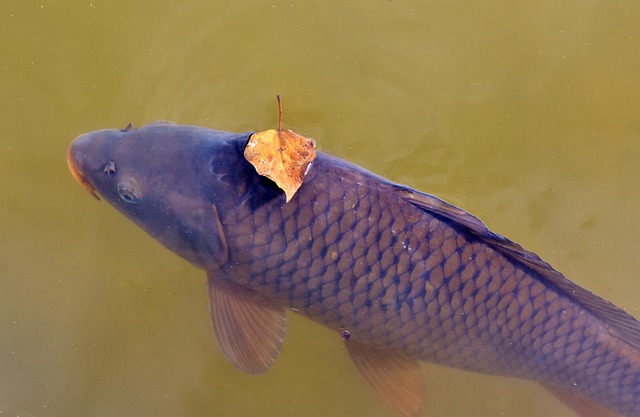
- Common Carp (Cyprinus carpio) North American, & Eurasian Mainland Rivers & Lakes
Catfish (Ictalurids)
There is one commonly-found species of catfish that can grow to tremendous size in the boreal forest.
The catfish family is known for its freshwater fish that have distinctive flattened heads, long whisker-like barbels around their mouths, and no scales.
Catfish are bottom feeders, scavenging for food on the river or lakebed, and are omnivorous, feeding on both plants and animals. Some species of catfish are also known for their impressive size and fighting ability, making them popular among anglers.

- Channel Catfish (Ictalurus punctatus) – Eastern North American Lakes & Rivers
Freshwater Eels (Anguillids)
There is also one commonly-found species of freshwater eel found in the boreal forest that can grow to a considerable size.
The freshwater eel family is known for its long, snake-like fish with a continuous dorsal, caudal and anal fin. They have a catadromous life cycle which means they spawn in the ocean but spend most of their adult lives in freshwater.
Freshwater eels have a mysterious and fascinating life cycle that has only recently been fully understood, as they migrate over thousands of miles to spawn in the ocean before returning to their freshwater habitats to mature.

Photo by Clinton / CC BY 2.0
- American Eel (Anguilla rostrata) – Eastern North American Lakes & Rivers
Mid-Sized Fish (12-24 inches)
Salmonids (Coregonus, Oncorhynchus, Prosopium, Salmo, Salvelinus)
There are 8 species of commonly-found mid-sized salmonids found in the North American boreal forests.
Fish in the salmonid family, such as whitefish and trout, are freshwater fish with streamlined bodies, silvery scales, and colorful speckled skin.
They are highly prized by anglers for their fighting spirit and delicious taste


- Lake Whitefish (Coregonus clupeaformis) – North American Lakes & Rivers
- Cisco (Coregonus artedi) – North American Lakes & Rivers


Photo by Liquid Art / CC BY-SA 4.0
- Rainbow Trout (Oncorhynchus mykiss) – North American & European Lakes & Rivers
- Cutthroat Trout (Oncorhynchus clarkii) – North American Lakes & Rivers

Photo by LevPN / CC BY-SA 3.0
- Round Whitefish (Prosopium cylindraceum) – North American, & Siberian Lakes & Rivers

Photo by Gilles Saint Martin / CC BY-SA 2.0
- Brown Trout (Salmo trutta) – North American & Eurasian Lakes & Rivers

- Brook Trout (Salvelinus fontinalis) – North American & European Lakes & Rivers

- Arctic Grayling (Thymallus arcticus) – Western North American Lakes & Rivers
Sunfishes (Centrarchids)
There are 3 commonly-found mid-sized sunfish species found in the boreal forests.
The freshwater sunfish family is known for its colorful, small to medium-sized fish that have a distinctive round body shape and spiny fins.
Sunfish are popular among anglers for their scrappy fighting ability and are often found in shallow, weedy areas of lakes and rivers.
Some species of sunfish are also popular aquarium fish due to their bright colors and active behavior.

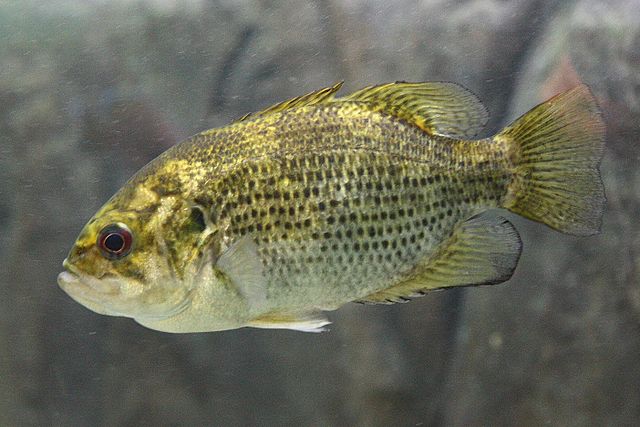
Photo by Cephas / CC BY-SA 3.0

- Pumpkinseed (Lepomis gibbosus) – Eastern North American & European Lakes & Rivers
- Rock Bass (Ambloplites rupestris) – Eastern North American Lakes & Rivers
- Smallmouth Bass (Micropterus dolomieu) – North American & European Lakes & Rivers
Bowfins (Amiids)
The bowfin family is known for its freshwater fish with a long, slender body and a distinctive “bow-shaped” dorsal fin.
Bowfins are voracious predators and have been called “living fossils” because they have remained relatively unchanged for over 150 million years. They are also known for their ability to breathe air using a primitive lung-like organ, which allows them to survive in oxygen-poor waters.
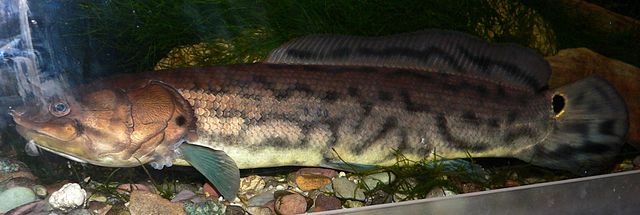
Photo By Stan Shebs / CC BY-SA 3.0
- Bowfin (Amia calva) – Eastern North American Lakes & Rivers
Suckers (Catostomidae)
The sucker family is known for its freshwater fish with a cylindrical body shape, downward-facing mouth, and rough, toothless lips.
Suckers are bottom feeders, using their specialized mouthes to suck up detritus, algae, and small invertebrates from the river or lakebed. Some species of sucker are also prized game fish, with anglers targeting them for their fighting ability and large size.
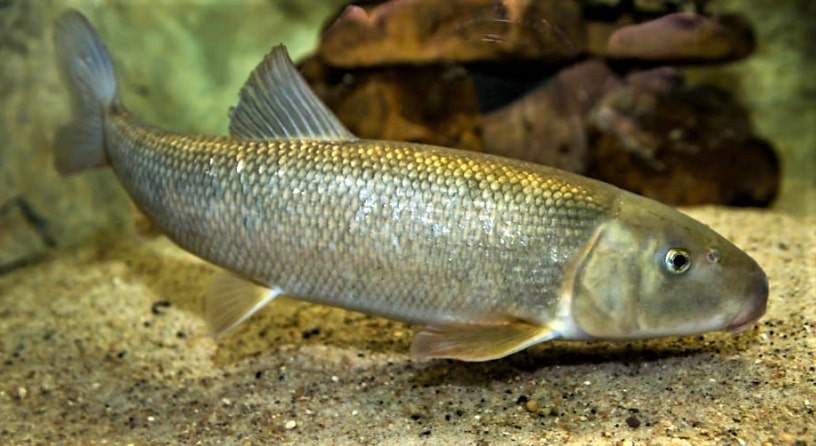

- White Sucker (Catostomus commersonii) – North American Lakes & Rivers
- Longnose Sucker (Catostomus catostomus) – North American, & Siberian Lakes & Rivers
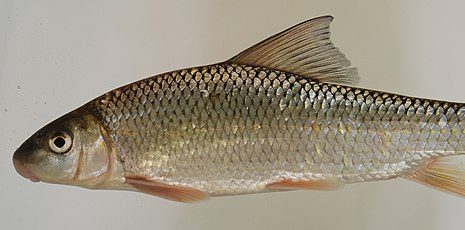
Photo By SERC / CC BY 2.0
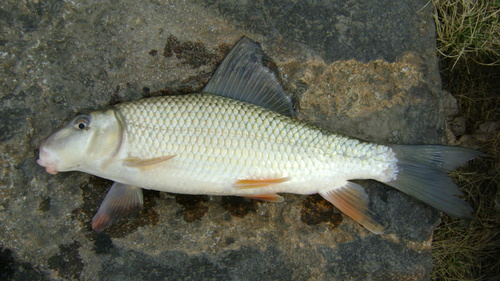
Photo by Bradley Rasmussen / CC BY-NC
- Shorthead Redhorse (Moxostoma macrolepidotum) – Eastern to Central North American Lakes & Rivers
- Silver Redhorse (Moxostoma anisurum) – Eastern To Central North American Lakes & Rivers

Photo by SERC / CC BY 2.0
- Quillback (Carpiodes cyprinus) – Eastern To Central North American Lakes & Rivers
Carps (Cyprinids)

Photo by A. Y. Suvorov / CC BY-SA 4.0
- Fallfish (Semotilus corporalis) – Eastern North American Lakes & Rivers
Cods (Gadids)
Atlantic tomcod are a small species of cod that are found in freshwater and brackish water systems along the Atlantic coast of North America.
They have a grayish-brown coloration and a distinctive barbel on their chin. Tomcod are known for their ability to tolerate a wide range of salinity levels and are a popular game fish among recreational anglers in the northeastern United States.

- Atlantic Tomcod (Microgadus tomcod) – Eastern North American Lakes & Rivers
Ray-finned Fishes (Clupeids)
Rain-fined fishes have a streamlined body shape with a deeply forked tail, and are found in both saltwater and freshwater environments.
Many species in this family are an important food source for both humans and marine predators, and they are often harvested for their high nutritional content and flavorful flesh.

- Alewife (Alosa pseudoharengus) – Eastern North American Lakes & Rivers
Drums (Sciaenids)
They have a distinctive, deep-bodied shape with a sloping forehead and a single, long dorsal fin.
Drum fish are known for their ability to produce low-frequency sounds using specialized muscles that vibrate their swim bladder, which is used to communicate with other fish and potentially even stun prey.

- Freshwater Drum (Aplodinotus grunniens) – Eastern North American Lakes & Rivers
Mooneyes (Hiodontids)
Mooneyes have a long, slender body and large eyes that are adapted for low-light conditions, allowing them to see well in murky water.
Mooneyes are known for their silvery coloration and are popular among recreational anglers, but they are also an important food source for many larger predators.

Photo by Noah Daun / CC BY-NC

- Goldeye (Hiodon alosoides) – North American Lakes & Rivers
- Mooneye (Hiodon tergisus) – Eastern North American Lakes & Rivers
Perchs (Percids)
Perches are known for their distinctive large, glassy eyes that reflect light, which helps them see in low-light conditions.
They have sharp teeth and are popular among anglers for their hard-fighting ability and delicious, flaky white meat. They are also unique in that they feed primarily during low-light periods such as dawn and dusk.
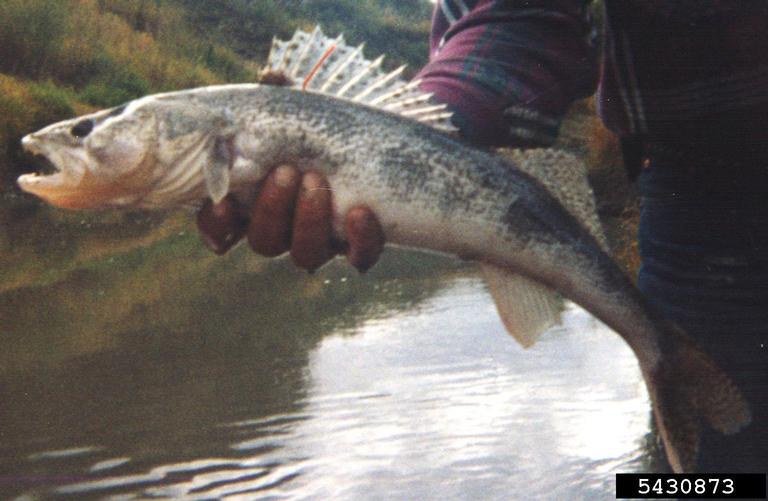
Photo by Dave Fuller / CC BY-NC


- Walleye (Sander vitreus) – North American & European Lakes & Rivers
- Sauger (Sander canadensis) – Eastern North American Lakes & Rivers
- Yellow Perch (Perca flavescens) – North American & European Lakes & Rivers
Lampreys (Petromyzontids)
Lampreys are jawless fish found in both freshwater and saltwater environments. They have a distinctive eel-like body shape and a circular, sucker-like mouth filled with rows of sharp teeth that they use to latch onto other fish and feed on their blood and bodily fluids.
Lampreys have a unique life cycle in which they spend part of their life in freshwater and part in the ocean, and some species are considered a delicacy in certain cultures.

Photo by Jelle Wissink / CC BY-SA 4.0
- Brook Lamprey (Lampetra planeri) – European & some Eastern North American Lakes & Rivers
Lings (Lotids)
Fish in the ling family, such as burbot, have elongated, eel-like bodies with a single dorsal fin and a barbel on the chin.
They are known for their unusual spawning behavior, as they lay their eggs in winter under the ice.
Burbot are also unique in that they are the only freshwater fish that has a liver that produces oil, which was historically used for lamp oil and as a traditional medicine.

- Burbot (Lota lota) – North American, & Eurasian Lakes & Rivers
Catfish (Ictalurids)

- Brown Bullhead (Ameiurus nebulosus) – North American & European Lakes & Rivers
Small Fish (Less than 6 inches)
Smelts (Osmerids)
Fish in the smelt family are small, slender fish with silvery scales and a pointed heads.
They have a unique odor and are often used as bait. Smelt are known for their interesting spawning behavior, in which they lay their eggs in gravel or sand beds in freshwater streams and rivers during the spring.

Darters & Logperchs (Percids)
Fish in the darter family are small fish with streamlined bodies and pointed snouts. They are known for their vibrant colors and unique markings, which vary between species.
Darters are also unique in their breeding behavior, as males will fan their fins to create a nest and then entice females to lay their eggs in the nest.


Sculpins (Cottids)
Sculpins are a family of small, bottom-dwelling fish with flattened heads and wide mouths.
They are known for their ability to blend in with their surroundings thanks to their mottled brown or green coloration, making them difficult to spot by predators. Some species are also known for their unique defense mechanisms, such as venomous spines and the ability to inflate themselves like a balloon.

Mudminnows (Umbrids)
Mudminnows are small freshwater fish with elongated bodies and pointed heads.
They have a mottled brown coloration and are known for their ability to breathe air through their skin in oxygen-poor environments. Some species of mudminnows are known to bury themselves in the mud to survive droughts.

Minnows, Shinners Chubs & Daces (Cyprinids)
Minnows, Shinners, Chubs, and Daces are a diverse family of small freshwater fish. They are known for their streamlined bodies and their ability to swim in large schools. Some species, such as the golden shiner, are popular baitfish for recreational fishing.

Sticklebacks (Gasterosteids)
Sticklebacks are small, spiny fish that are known for their unique armor-like plating. They are often found in shallow freshwater streams and ponds, and some species even have the ability to adapt to saltwater environments.
Sticklebacks are also notable for their courtship behaviors, which can include elaborate dances and building nests out of plant materials.

Resources
Online
- Poissons D’eau Douce du Quebec et des Maritimes, 2013 – Jean-Francois Desroches – Isabelle Picard
- Faune et Flore de L’Amerique du Nord, 1995 – Reader’s Digest
- Animals, Birds, and Fish of North America, 2011 – Tom Jackson
Want to discover more about the boreal forest? You might like our other articles:




